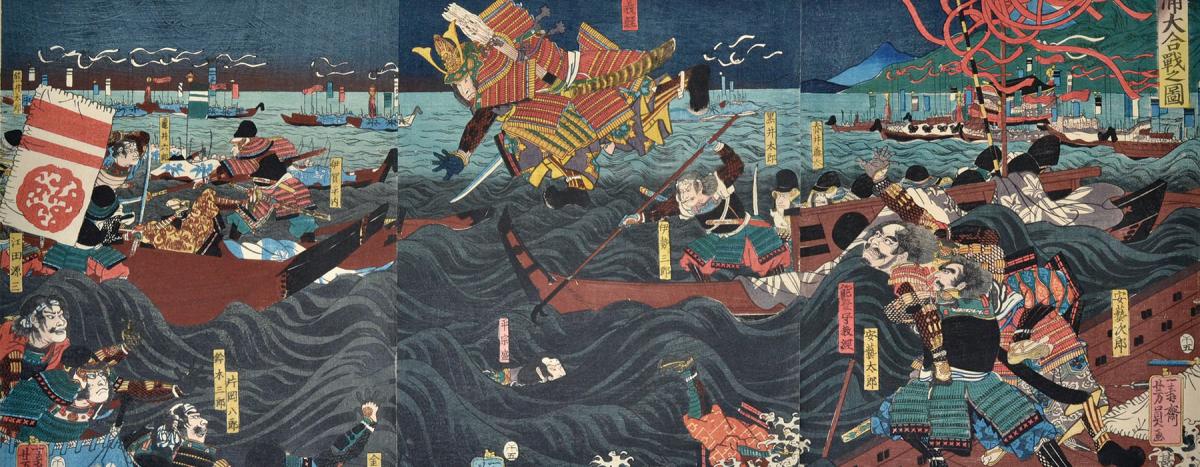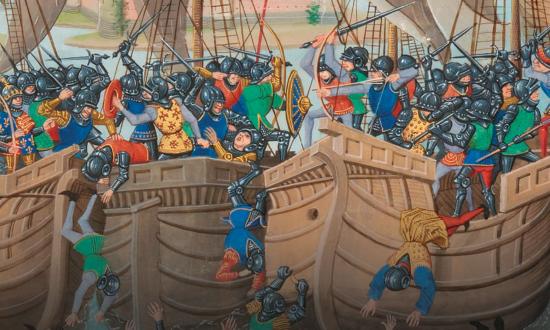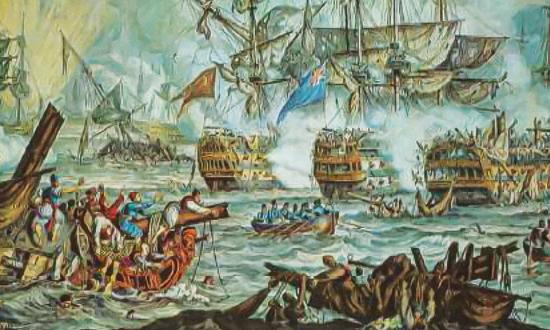From time immemorial, supreme power in Japan had rested in the Court of the Emperor, the Tennō, “the Heavenly Sovereign.” But by the 12th century, the Imperial authority was standing in the path of a surging force—that of the great samurai clans.
Imbued with the warrior spirit of bushido, they were indefatigable, highly skilled fighting men, masters of horsemanship, mounted archery, and the way of the sword. Sundry houses held sway in disparate regions, but as the titanic civil war that would define the future of Japan erupted in 1180, most samurai soon would be rallying either to the red banner of the dominant Taira clan, centered in the west, or to the white banner of the up-and-coming Minamoto clan, based in the east.
It was the most significant conflict Japan had ever known: the Gempei War. At the outset, the Taira clan clearly had the upper hand; its leadership had wormed itself into the Imperial Court at Kyoto. Through marriages into the Imperial line, a scion of the Taira clan had been declared boy-emperor. But a rival claimant to the Emperor title protested, and the Minamoto clan pounced on the opportunity—and the justification it provided to ride forth to crush the detested Taira once and for all.
Among those leading the charge was the legendary Minamoto Yoshitsune, one of the most revered samurai in Japanese history. So renowned was his martial prowess that it was said that the tengu, the fearsome goblins of the forest, had taught him the art of swordsmanship. In a series of hard-fought battles from 1183 on, Yoshitsune forced the Taira ever farther back on their heels until, on 25 April 1185, he met the foe in the ultimate showdown that would seal the fate of the Land of the Rising Sun: a decisive naval engagement known to history as the Battle of Dan-no-ura.
The oared galley fleets faced off in the fickle, shifting waters of the Shimonoseki Strait separating Honshu and Kyushu. To the east, the Minamoto fleet was arrayed in line abreast across the strait’s entrance. To the west, the Taira fleet took advantage of the strong morning tide in their favor to advance in three squadrons and attempt to simultaneously hit the enemy in the center and on both flanks. As the Taira galleys drew near, Minamoto Yoshitsune ordered his archers to target the oncoming vessels’ helmsmen to sow disarray; he himself meanwhile was engulfed “by the arrows of the foe that fell like rain on his shield and armor,” and as the Taira pressed closer with the favorable tide, “the roar of their shouting mingled with the booming of their war drums that continuously sounded.”
The fleets careened into each other, and arrows gave way to samurai swords, crafted to such sharp perfection that a well-placed slice hewed sinew and bone like a mighty razor, and the decks ran red amid the din of battle. Then, fortuitously for the Minamoto, the tide turned—both literally and figuratively. Now, with the swift water working to their benefit, they began to push back the Taira, and as nature now favored the Minamoto, so too did fortune, in the form of a betrayal: One of the Taira’s commanders abruptly switched loyalties and joined the Minamoto. He revealed to his new allies the location of the fleeing boy-emperor and his retinue—concealed in a small, nondescript vessel that now became the focus of the crushing Minamoto counterattack.
Sensing that the end was nigh, the boy-emperor’s grandmother gathered up the Sacred Jewel and the Sacred Sword (ancient symbols of Imperial might), grabbed the boy-emperor, and plunged into the deep. While the Sacred Jewel later was recovered, the Sacred Sword of Japan has never been found; since that fateful afternoon in 1185, a replica sword has held its place in the Imperial regalia.
The water had turned crimson—both from blood and from the red dye of all the fallen banners of a fallen clan. And to this day, it is said that the heike crabs that live in the Shimonoseki Strait house the spirits of dead Taira warriors.
The days of a powerful Imperial Court were over. The days of the Shogun had begun. The Minamoto founded the Kama----kura Shogunate, a military overlordship with the Emperor but a figurehead. Through the ensuing centuries and the subsequent Ashikaga and Tokugawa Shogunates, samurai rule would shape the culture and mindset of Japan, all the way until 1868.
And in the modernized Japan that followed, the spirit of bushido would rise again. . . .
Sources:
Heike Monogatari (The Tale of the Heike), A. L. Sadler, trans., in Transactions of the Asiatic Society of Japan (Tokyo, London: Kegan Paul, Truebner & Co. Ltd., 1918), vol. 46, part II, 416–26.
Jeffrey P. Mass, “The Kamakura Bakufu,” in Warrior Rule in Japan, Marius B. Jansen, ed. (Cambridge, UK: Cambridge University Press, 1995), 1–43.
Helen Craig McCullough, Yoshitsune: A Fifteenth-Century Japanese Chronicle (Stanford, CA: Stanford University Press, 1966), 20–24.
Stephen Turnbull, The Gempei War, 1180–85: The Great Samurai Civil War (Oxford, UK: Osprey, 2016).







